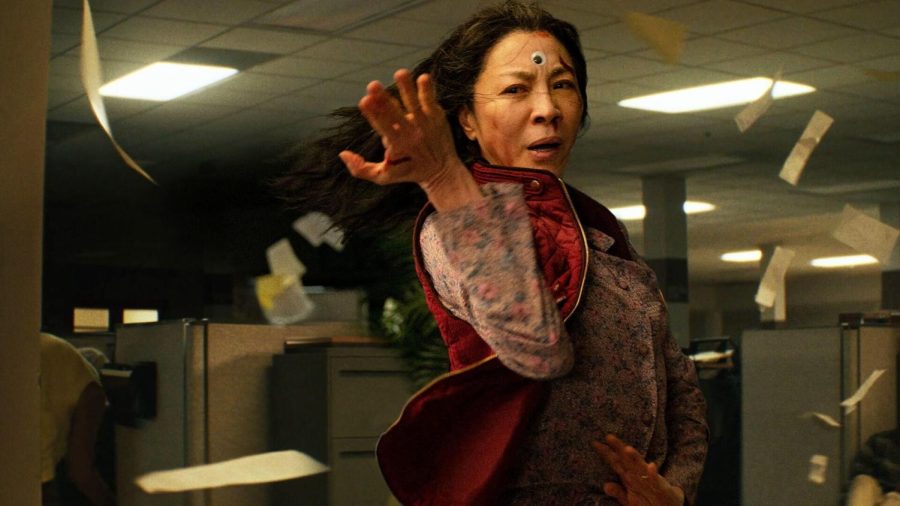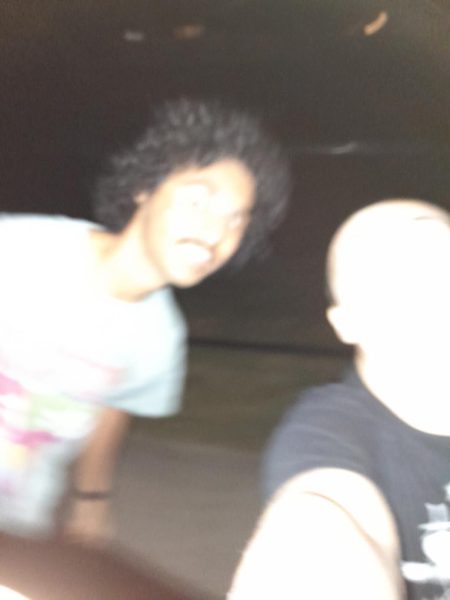Expressionism (in film) at its Finest: Everything Everywhere All at Once
May 2, 2023
The 95th annual Academy Awards ceremony was held on March 12th this year. A24 boasted several rewards from their films ‘‘The Whale’’ and ‘‘Everything Everywhere All At Once’’, with the latter winning awards for the best picture and best actresses in leading and supporting roles (as well as best actor in a supporting role). For a film of such critical acclaim among critics and movie fans (holding a very high 4.4/5 on Letterboxd), discussion for the reasoning of such high regard is only expected.
What is it about?
Starring Michelle Yeoh, Ke Huy Quan, Stephanie Hsu, Jamie Lee Curtis, and others, the movie is difficult to explain in a plot analysis. Tackling the mere message, it is a film that deals with the generational trauma that so many minority families (in this case, Asian-American families) suffer from and how to change the vicious cycle with the understanding of compassion and unconditional love. To make the themes unobtrusive, the messages are mixed in with a Matrix-esque backdrop of inter-reality traveling, as the characters constantly merge with their other, alternate selves from parallel dimensions that give them combinations of abilities they would never be able to attain in their current, original state. The main character is supposedly living in their worst parallel possibility, which allows her to obtain traits and jump to these alternate dimensions without the consequence of overexposure to her brain and the ability to control these new traits that she gained from fusing with her alternate dimensional possibilities. As I said, confusing. To avoid spoilers, the enemy is not the enemy (as for some reason, real death is brushed aside as nothing much) as much as the enemy is what should be remedied and saved (like a barely curable illness).
How is this good in any way?
Reading the exposition only increases confusion for most, so a recommendation to see the movie is warranted to fully comprehend the level of uniqueness the movie displays in the realm of modern filmmaking. The movie draws on many different sources of influence, from directors like Wong Kar-Wai and films like Ratatouille or the Matrix. This mesh of influences allows the movie to create its unique voice amongst the crowd of these ideas. While not creating the material for the movie, it allows for the themes of the movie to be propped up upon the layers of plot and storytelling (through several different perspectives, which can be confusing to follow at times). If one can follow the plot of the story with the constant switching of languages between English and Cantonese, the viewer is rewarded with a sincerely meaningful story that has rarely been executed as well as in this movie, as the reasons for what the characters do what they do is all tied up, although not perfectly, to the extent that the characters need it to (which supports the message of the movie). The story structure of the movie destroys the norm of how storytelling is accomplished through film, as previously mentioned, it is not scared to break the constancy of perspective, allowing for different characters’ inner dialogue to invade the space of the main character at any given moment (and even take over the scene at times). Jumping around several plotlines (that all tie into the central story) is conceptually nauseating, but the inherent importance of light being shined upon these differing perspectives contributes not only to worldbuilding but displaying the stakes that every dimension that Evelyn (the main character) is exposed to.
Who should watch this?
I believe that everyone should view this movie, but the elements of the movie do allow it to become a sort of turn-off for certain movie audiences. The themes of generational trauma (and its healing), the nature of respect through understanding different circumstances, and the advocacy of peace instead of the internal instinct of conflict are all showcased underneath the intense ‘‘IP Man’’ and ‘‘Kill Bill’’-inspired fight scenes and interdimensional travel, which for many is an interesting path to take such subjects down. This breaks them down from being uncomfortable conversations relayed to the viewer into plot-heavy scenes of character building that allow for real-life messages to be exerted onto the viewer, supporting family conversations that could start by simply watching the movie. Any appreciators of film, social values, family ties, cross-generational stories, and Asian-inspired cultural showcases would be interested. Even you Marvel fans would find some entertainment within the fight scenes (even if there is some lack of understanding plot-wise). The absurdity of some of the situations grants its rightful R-rating, but that only works to the benefit of the movie. This is the one (and most likely only) movie where I can find myself becoming emotional over an alternate dimension of the main characters (that was exhibited on-screen for about less than 5 minutes) where they have these absurdly giant sausage fingers. That speaks volumes for the emotional control of the movie on its audience, so if you’re looking for a movie to laugh, cry, excite, and come out of with new understandings of the lives of others as well as your own, this is an optimal choice.


